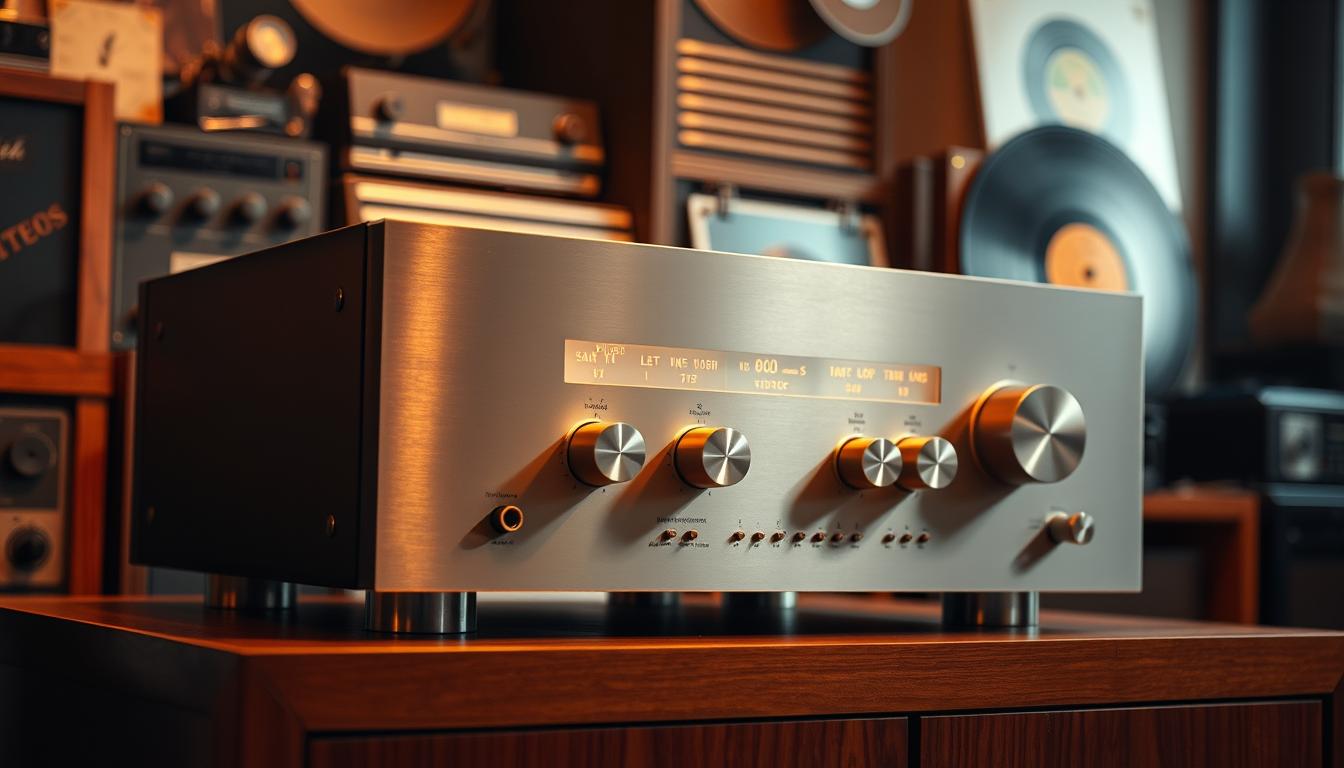Have you heard of McIntosh? It’s a legendary brand in high-quality audio equipment. McIntosh has been leading in sound quality for over seven decades.
For those who love music, exploring McIntosh receiver models is a journey. It’s a path of innovation and top-notch sound quality. You’ll see how McIntosh receivers have set the standard in the industry.
This article will take you through the major highlights in McIntosh receivers’ history. We’ll look at the key features and advancements that have made them famous.
Key Takeaways
- Overview of McIntosh’s history in the audio industry.
- Evolution of McIntosh receiver models over the years.
- Key features that make McIntosh receivers stand out.
- Significant milestones in McIntosh receiver history.
- What to expect from the article.
The Legacy of McIntosh Receivers
McIntosh receivers are known for their innovative design and top-notch audio. For years, they’ve been a key part of the audiophile world. Their receivers are famous for quality sound.
![]()
The McIntosh Philosophy and Sound Signature
McIntosh’s success comes from a focus on pure sound. Their receivers offer a rich, detailed sound that’s both warm and accurate. This makes their receivers a top choice for those looking for McIntosh Stereo Receiver Information.
Why McIntosh Receivers Stand the Test of Time
McIntosh receivers last because of their quality, new tech, and dedication to excellence. When comparing McIntosh Receiver Comparison models, it’s clear McIntosh’s legacy impacts high-fidelity audio.
These receivers are a smart buy for audiophiles. McIntosh is known for making receivers that work well and look great. This has earned them a dedicated fan base.
The Birth of Excellence: Early McIntosh Receivers (1950s-1960s)
McIntosh started making stereo receivers in the 1950s. This was a key time for the company. It marked their move into the stereo era, shaping their future in audio.
![]()
The MAC1500: McIntosh’s First Stereo Receiver
The MAC1500 was McIntosh’s first stereo receiver, launched in the late 1950s. It was a game-changer, blending new design with top-notch sound. For those looking into vintage receivers, the Marantz receiver models guide offers insights into vintage audio.
Technical Specifications and Innovations
The MAC1500 had many technical firsts, like its power output and low distortion levels. It aimed to provide high-quality stereo sound, appealing to audiophiles.
Historical Significance and Market Impact
The MAC1500 was a turning point for McIntosh. It helped establish the brand as a top name in audio. Its release set a new benchmark for stereo receivers.
The MAC1700: Setting New Standards
After the MAC1500’s success, McIntosh released the MAC1700. This model improved on the company’s stereo receiver tech. The MAC1700 is known for its exceptional performance and durability.
Design Evolution and Performance Enhancements
The MAC1700 had design upgrades, like better power output and improved circuitry. These changes made it a top choice for audio enthusiasts.
Collector Value and Availability
Today, the MAC1700 is a collector’s dream. Its rarity and condition greatly affect its value. Well-kept models are highly sought after.
The Golden Age: McIntosh Receivers of the 1970s
The 1970s were a golden time for McIntosh. They introduced iconic receivers that changed the game in high-fidelity audio. This decade was all about big leaps in technology and sound quality.
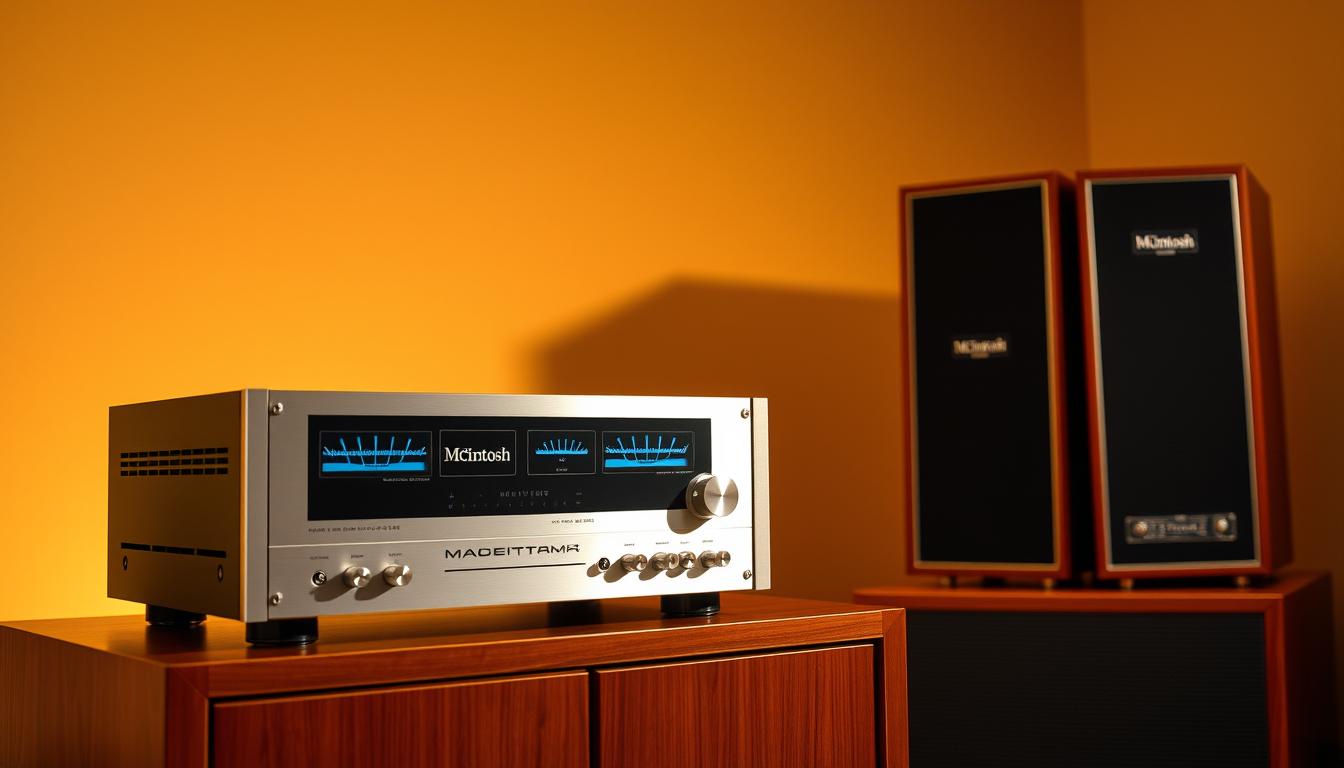
The MAC1900: Power and Precision
The MAC1900 was a game-changer. It was known for its power and precision. It marked a big step forward in receiver design.
Amplifier Section and Tuner Capabilities
The MAC1900’s amplifier section was top-notch. It delivered strong power with little distortion. Its tuner also got better, giving clearer reception and more precise tuning.
Distinctive Features and Controls
The MAC1900 had a unique control layout. It made adjusting settings easy. Its quality and design made it a favorite among audiophiles.
The MAC4100: Advancing the Technology
The MAC4100 pushed McIntosh’s tech even further. It brought new circuit innovations and sound quality. It showed McIntosh’s dedication to innovation.
Circuit Innovations and Sound Quality
The MAC4100’s circuit innovations greatly improved sound quality. It offered a richer and more detailed listening experience.
Market Position and Consumer Reception
The MAC4100 won over both consumers and critics. It helped solidify McIntosh’s market position. It became a key part of many high-end audio systems.
In the McIntosh Receiver Collection In Review, the MAC1900 and MAC4100 stand out. They show McIntosh’s focus on quality and innovation. For those looking at the McIntosh Vintage Stereo Receiver List, these models are must-haves.
McIntosh Receiver Models By Year: The 1980s Revolution
In the 1980s, McIntosh introduced the MAC4200 and MAC4300V. These models marked a big change in audio technology. They brought new features that excited audiophiles.
![]()
The MAC4200: Digital Innovations
The MAC4200 was a game-changer. It showed McIntosh’s move into digital technology. It mixed the best of analog and digital sounds.
Integration of Digital Technology
The MAC4200 was the first McIntosh with digital tech. It improved sound quality and cut down on distortion. This was a big leap forward for listeners.
Performance Metrics and Listening Experience
The MAC4200’s sound was clear and detailed. It handled complex sounds well. This made it a hit with audiophiles.
“The MAC4200 represented a bold step into the digital age for McIntosh, and its impact was felt across the audiophile community.”
The MAC4300V: Versatility Redefined
The MAC4300V took McIntosh’s digital journey further. It offered more versatility and better performance. It suited many audio needs, from simple to complex setups.
Multi-Room Capabilities and Expanded Inputs
The MAC4300V’s multi-room feature was a highlight. It let users play music in different rooms. It also had more inputs for connecting various devices.
Design Evolution and Build Quality
The MAC4300V’s design showed McIntosh’s focus on quality. Its sturdy build and sleek look made it a great addition to any setup.
| Model | Key Features | Notable Innovations |
|---|---|---|
| MAC4200 | Digital signal processing, improved SNR | First McIntosh receiver with digital technology |
| MAC4300V | Multi-room capability, expanded inputs | Enhanced versatility and performance |
The 1980s were a turning point for McIntosh. The MAC4200 and MAC4300V were key. They showed McIntosh’s innovation and set new standards.
The Transition Era: McIntosh Receivers of the 1990s
In the 1990s, McIntosh introduced new receiver models. These models mixed traditional analog strengths with new digital features. This was a key time for McIntosh, as it moved from analog to digital technologies. The result was receivers that met and exceeded what audiophiles wanted.
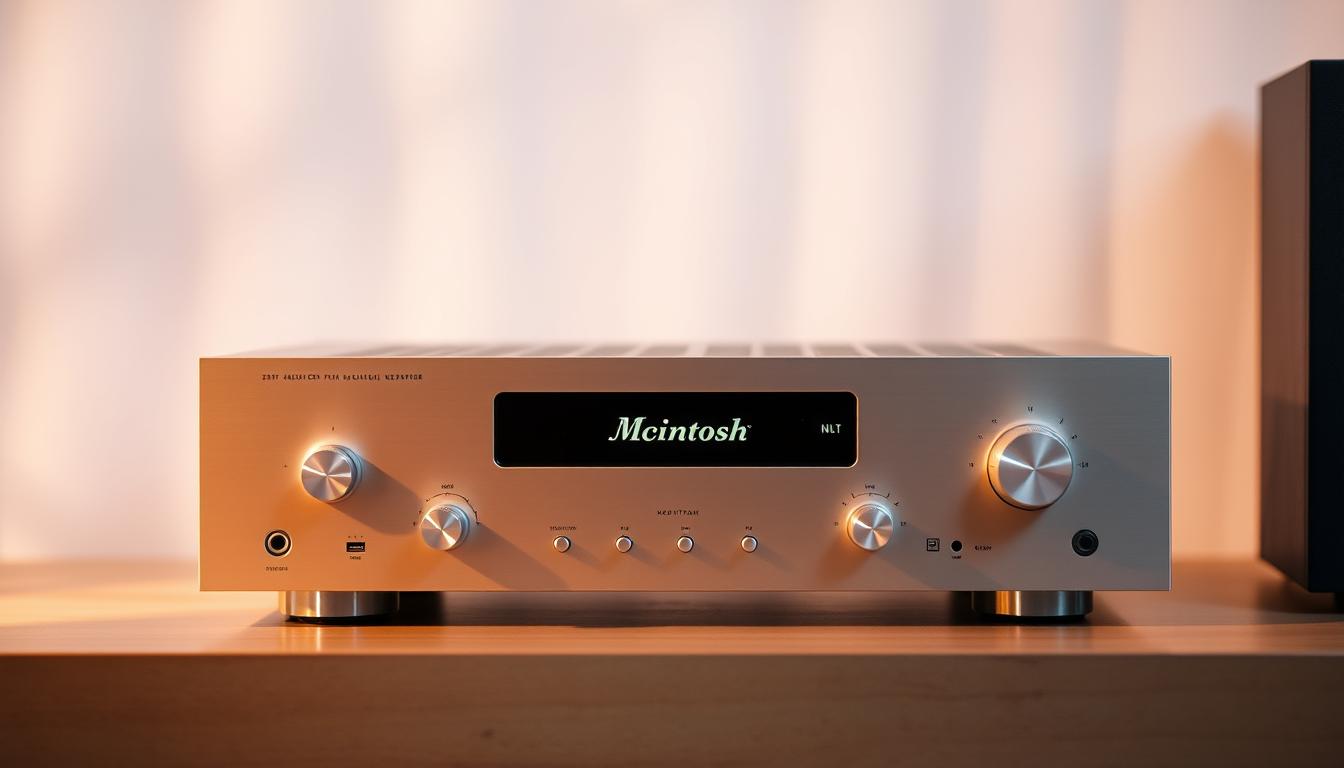
The MAC7000: Bridging Analog and Digital
The MAC7000 was a major step for McIntosh. It combined analog and digital audio in a way that impressed many. It was perfect for those wanting to upgrade their sound systems.
Digital Processing Capabilities
The MAC7000 had advanced digital signal processing. This allowed for detailed control over audio settings. It was a hit with audiophiles who loved to tweak their sound.
Audiophile Performance Characteristics
Even with its digital features, the MAC7000 kept McIntosh’s signature sound. It was known for its warmth and richness. This made it a top choice among audiophiles.
The MAC7200: Home Theater Integration
The MAC7200 was another big step for McIntosh. It added home theater features to McIntosh’s famous receiver design. It was great for those wanting a full audio experience at home.
Surround Sound Processing Features
The MAC7200 had advanced surround sound processing. It could handle many surround sound formats. This made it perfect for a home theater setup.
Connectivity Options and Flexibility
The MAC7200 had many connection options. This made it flexible and convenient. Users could connect many sources for a seamless listening experience.
Experts say the MAC7000 and MAC7200 show McIntosh’s innovation and commitment to quality. Audiophiles agree, praising these models for combining analog and digital strengths.
“McIntosh’s 1990s receivers, such as the MAC7000 and MAC7200, showcased the company’s forward-thinking approach to audio technology, setting a new standard for receiver design and functionality.”
Modern Masterpieces: McIntosh Receivers from 2000-2010
McIntosh pushed audio tech limits in the 2000s with top-notch receivers. These models brought new tech to improve sound quality and listening experience.
The MHT200: Home Theater Excellence
The MHT200 was a top model showing McIntosh’s focus on home theater. It had advanced features for a better home theater experience.
Audio/Video Processing Capabilities
The MHT200 had advanced audio/video processing. It made mixing audio and video sources smooth. This led to clearer, more detailed sound.
Integration with Modern Entertainment Systems
The MHT200 was great for modern entertainment systems. It was perfect for those wanting to update their home theater with the latest tech.
The MR85: Tuner Technology Perfected
The MR85 was known for its top-notch tuner tech. It raised the bar for radio quality and durability.
Advanced Radio Reception Features
The MR85 had better radio reception. It had improved sensitivity and selectivity. This meant listeners could enjoy their favorite stations with better clarity.
Build Quality and Component Selection
McIntosh was famous for its focus on build quality and component choice. The MR85 was no different, with high-quality parts for lasting reliability and sound.
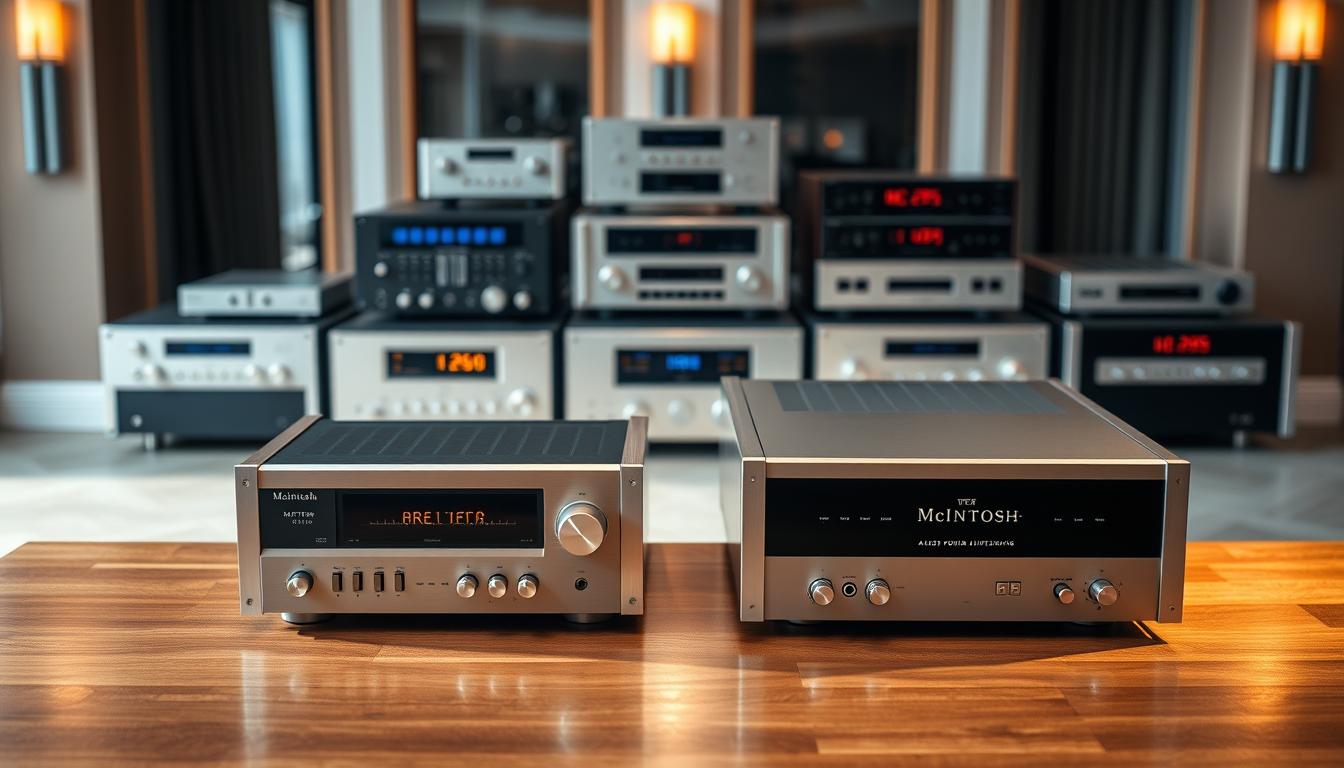
In summary, McIntosh receivers from 2000-2010, like the MHT200 and MR85, were big steps forward. They showed McIntosh’s commitment to innovation and quality. These models are highly valued by audiophiles.
Contemporary Classics: McIntosh Receivers from 2010-Present
McIntosh has been making receivers that mix tradition with new tech. These models have changed the audio world with their advanced features and classic looks.
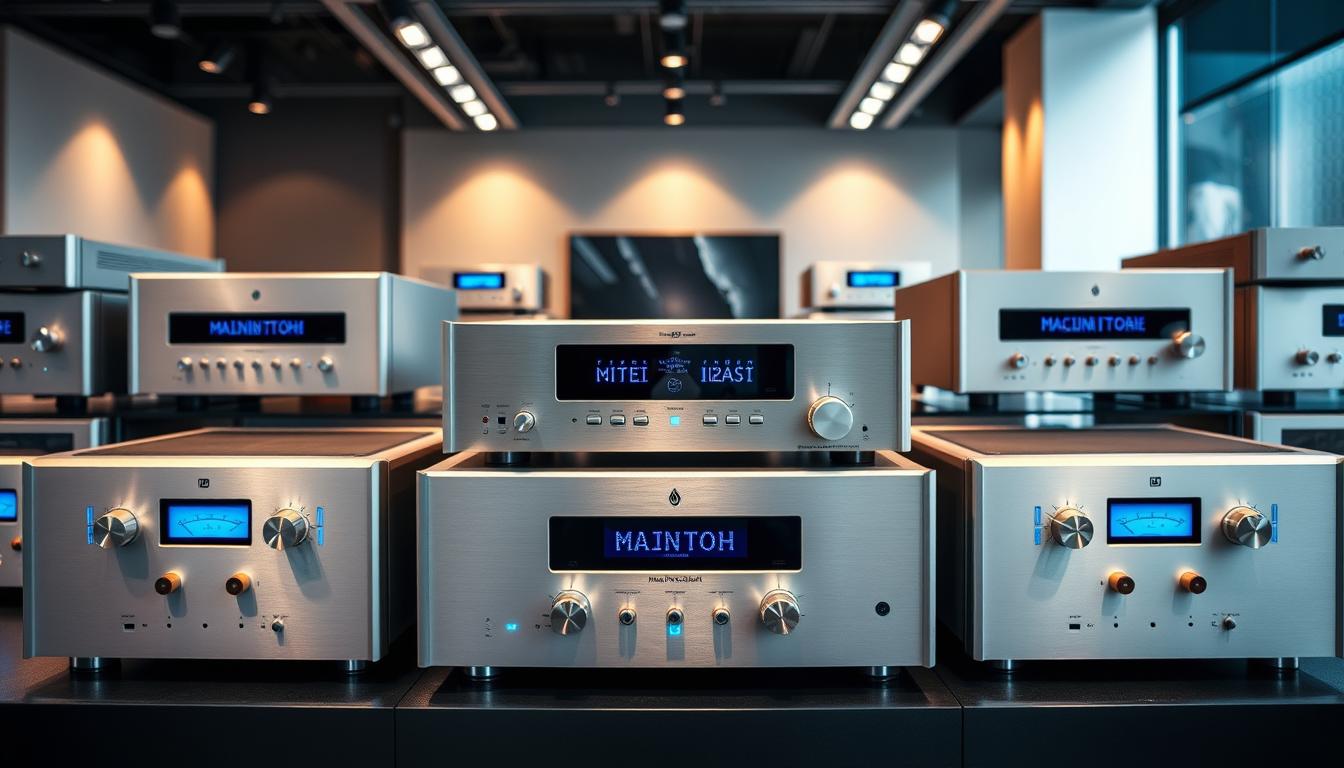
The MR87: Modern Connectivity
The MR87 shows McIntosh’s focus on modern streaming and connectivity. It meets the needs of today’s music lovers with its advanced tech.
Digital Streaming Capabilities
The MR87 makes streaming music easy. You can quickly find your favorite tunes. Its user-friendly design makes it simple to use.
Sound Quality and Performance Metrics
The MR87 delivers McIntosh’s famous sound quality. It plays music clearly and with precision. Its design aims to give you a full, immersive sound experience.
The MAC7200: Tradition Meets Innovation
The MAC7200 combines McIntosh’s history with new tech. It’s made for today’s audio fans.
Advanced Features and Technologies
The MAC7200 has cool features like high-definition audio processing and multi-room capabilities. These features make your listening better, with more flexibility and sound quality.
Critical Reception and User Experiences
People love the MAC7200 for its sound and design. They say it’s robustly built and has easy controls. It’s a top choice for music lovers.
In short, McIntosh’s receivers from 2010 to now show the brand’s commitment to quality and innovation. Models like the MR87 and MAC7200 keep raising the bar for audio excellence.
Technical Innovations in McIntosh Receivers Through the Decades
McIntosh receivers have led the audio technology field for years. They’ve introduced many innovations that have changed the industry. Their focus on quality and performance has led to the creation of unique technologies.
Proprietary McIntosh Technologies
McIntosh is famous for its cutting-edge technologies, like Power Guard and Autoformers. These ensure the receivers work safely, preventing damage and keeping sound quality high.
Power Guard and Autoformers
Power Guard watches the output signal and stops clipping. Autoformers adjust speaker impedance to match the amplifier’s output. Together, they offer top performance and protection.
Output Transformers and Protection Circuits
McIntosh receivers have output transformers for handling high power. They also have protection circuits to prevent overheating and other problems.
Audio Circuit Evolution
The evolution of McIntosh receivers has seen big steps in analog design philosophy and digital integration strategies. These advancements have improved the audio experience.
Analog Design Philosophy
McIntosh’s analog design philosophy aims to keep the audio signal pure. This ensures the receivers deliver high-quality sound.
Digital Integration Strategies
The use of digital integration strategies has helped McIntosh receivers keep up with modern audio sources. They support various digital formats and offer different connectivity options.
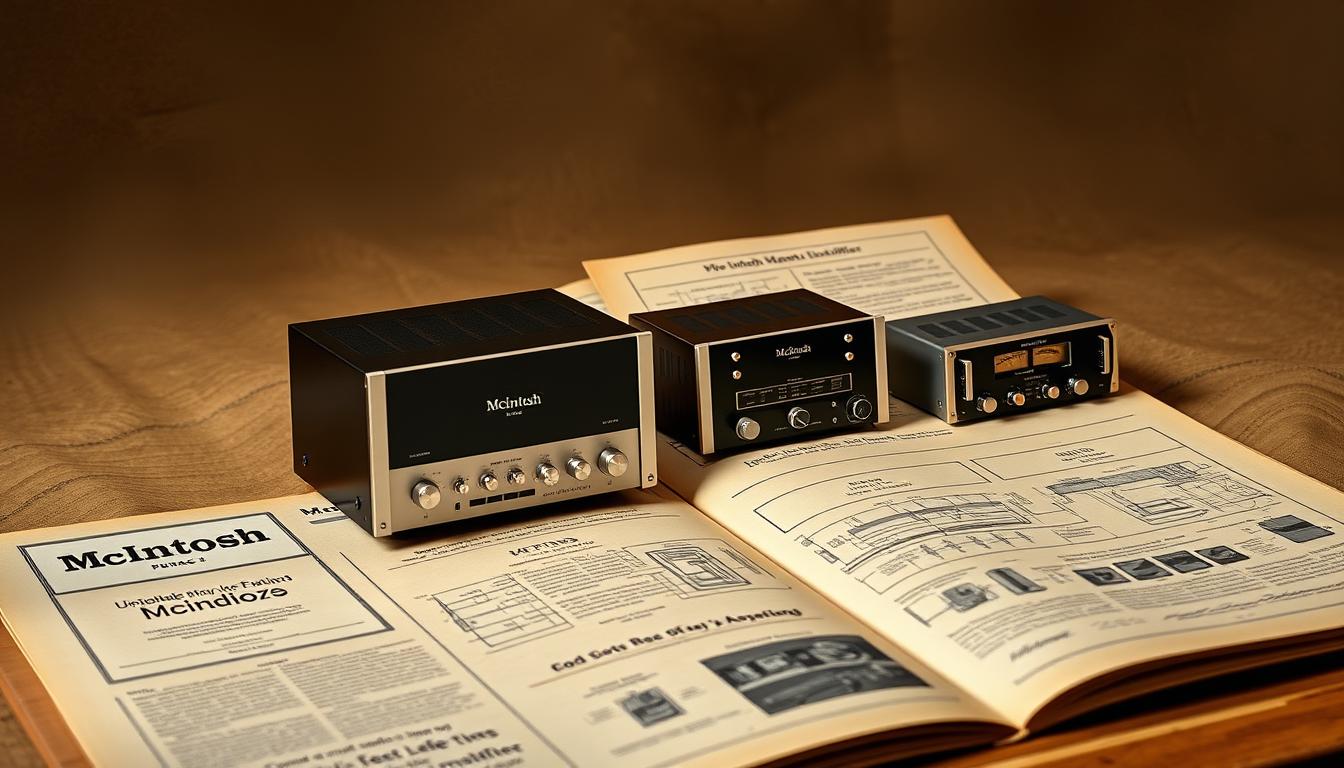
By combining innovative technologies with a dedication to quality, McIntosh has become a top name in the audio industry. Their receivers are known for their performance and durability.
Identifying McIntosh Receiver Models: A Visual Guide
To truly appreciate McIntosh receivers, it’s key to know how to spot different models by their looks. McIntosh receivers stand out with their unique design, like the iconic blue meters and changing front panels.
Signature Design Elements
McIntosh receivers have a few key design elements that make them instantly recognizable. One of the most famous is their iconic blue meters. These meters are not just pretty; they also show the receiver’s power.
The Iconic Blue Meters
The blue meters on McIntosh receivers are more than just a pretty sight. They also tell you how much power the device has. This feature has been a part of McIntosh designs for years, adding both function and a unique look.
Front Panel Layout Evolution
Over time, the front panel of McIntosh receivers has changed a lot. New features have been added, but the classic look has stayed the same. Spotting different models is easy by looking at these changes.
![]()
Serial Number Decoding and Authentication
Knowing your McIntosh receiver’s serial number is very important. It tells you if the receiver is real and when it was made. McIntosh has used different serial numbers over the years, and knowing how to read them is key.
Production Date Identification
By decoding the serial number, you can find out when your McIntosh receiver was made. This info is very useful for collectors and fans who want to know their equipment’s history.
Spotting Counterfeits and Modifications
Unfortunately, fake McIntosh receivers and parts do exist. It’s important to know how to spot these fakes and any unauthorized changes. This helps keep your McIntosh receiver real and valuable.
| Model | Production Years | Notable Features |
|---|---|---|
| MAC1500 | 1966-1970 | First stereo receiver, blue meters |
| MAC1900 | 1970-1974 | Enhanced power output, refined design |
| MAC4200 | 1980-1984 | Digital innovations, versatile functionality |
Collecting Vintage McIntosh Receivers: What to Look For
The world of vintage McIntosh receivers is filled with history and great sound. To explore it well, you need to know what to look for. Whether you’re an experienced audiophile or just starting, knowing the value and authenticity of vintage McIntosh receivers is key.
Condition Assessment and Evaluation
Checking a vintage McIntosh receiver’s condition is important. It involves looking at its appearance and making sure it works. A receiver that looks good but doesn’t work is not valuable to collectors.
Cosmetic Considerations
The look of a vintage McIntosh receiver greatly affects its value. Look for any wear, damage, or if it’s been fixed. Collectors love original finishes and parts.
Functional Testing Procedures
To make sure a vintage McIntosh receiver works, test it thoroughly. Check all inputs, outputs, and controls to see if they work right.
Value Indicators and Market Trends
The value of a vintage McIntosh receiver depends on several things. These include how rare it is, its condition, and how much people want it. Knowing the current market trends helps you make smart choices when buying.
Rarity and Production Numbers
Rare models or those made in small numbers are more valuable. Finding out how many of a model were made can help you guess its value.
Documentation and Original Accessories
Having original documents and accessories can increase a vintage McIntosh receiver’s value. Collectors often look for units with their original boxes, manuals, and remote controls.
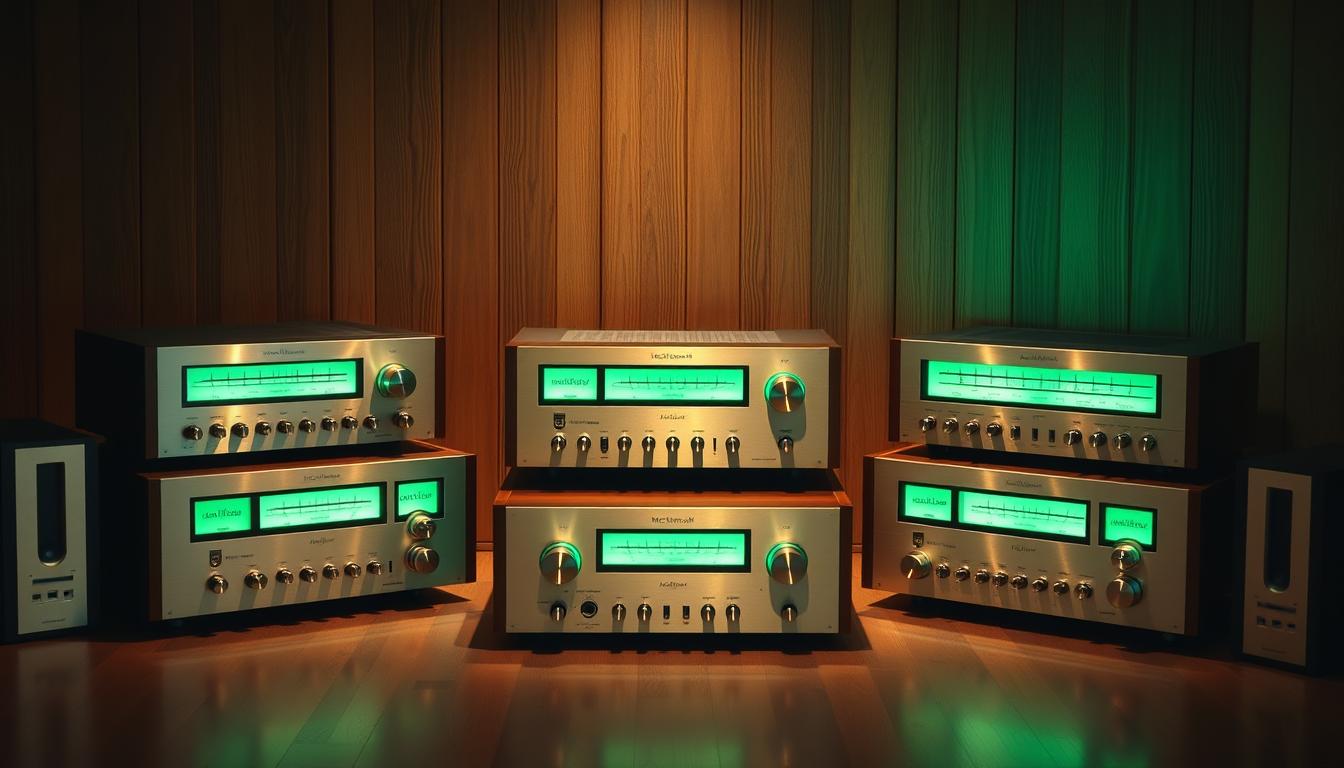
| Model | Year | Condition | Value |
|---|---|---|---|
| MAC1500 | 1960s | Restored | $1,500 |
| MAC1900 | 1970s | Original | $2,000 |
| MAC4200 | 1980s | Functional | $1,000 |
By carefully looking at a vintage McIntosh receiver’s condition, rarity, and demand, collectors can make smart choices. This helps them build a valuable collection.
Restoration and Maintenance of McIntosh Receivers
Restoring McIntosh receivers is an art. It involves fixing common problems and choosing between doing it yourself or hiring a pro. Knowing how to restore them is key to keeping their legendary sound.
Common Issues and Solutions
Like any vintage gear, McIntosh receivers can wear out. Issues include bad capacitors, dirty switches, and old potentiometers.
- Capacitor Replacement: Old capacitors can cause hum or distortion. Replacing them can greatly improve sound quality.
- Switch and Potentiometer Restoration: Cleaning or replacing these parts can fix balance and volume control problems.
Capacitor Replacement and Recapping
Recapping means swapping old capacitors for new ones. This can make the receiver sound better. It’s important to use high-quality capacitors that match the originals.
Switch and Potentiometer Restoration
Cleaning switches and potentiometers can fix connectivity issues. If they’re too worn, you might need to replace them.
Professional vs. DIY Restoration
You can restore your McIntosh receiver yourself or hire a pro. Both options have their benefits.
- Professional Restoration: Experts can find and fix complex problems, ensuring a top-notch job.
- DIY Restoration: If you enjoy DIY, fixing a McIntosh receiver can be fulfilling. There are many online resources to help.
Finding Qualified Technicians
If you choose professional help, find technicians with experience in vintage McIntosh gear. Look for reviews and ask for references.
Resources for Self-Service
For DIY fans, online forums, manuals, and tutorials are great resources. Always follow safety rules when working with electrical parts.
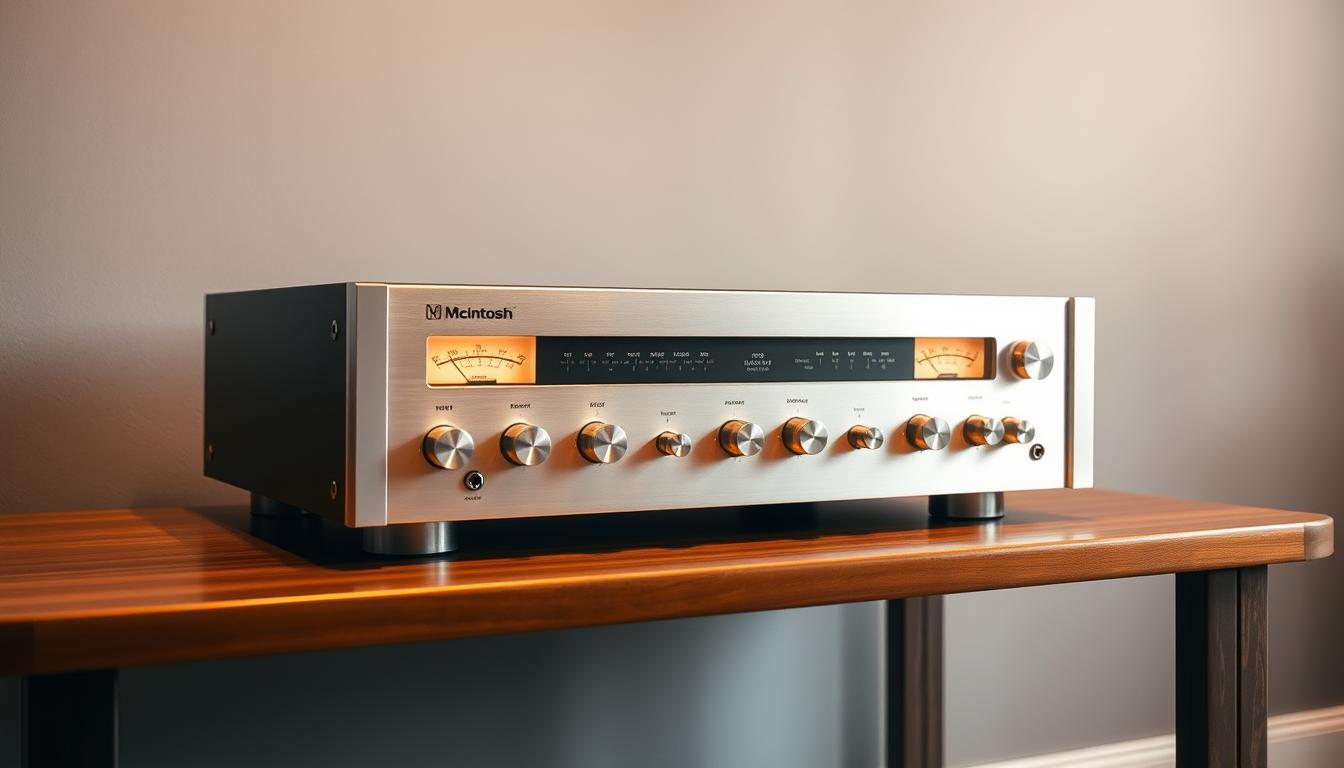
Integrating McIntosh Receivers with Modern Audio Systems
To get the most out of your McIntosh receiver, it’s key to know how to pair it with modern audio gear. This means looking at digital source compatibility and speaker matching. These steps help create a system that sounds great and works well together.
Digital Source Compatibility
McIntosh receivers are famous for their top-notch sound quality. When paired with modern digital sources, they offer an unmatched listening experience. Here are some key points to consider for digital source compatibility:
Streaming and Network Audio Solutions
Many modern McIntosh receivers have network audio features. This lets you stream music from various services. For example, you can use high-end receiver comparison to pick the best one for streaming.
DAC Integration and Digital Inputs
If you have external DACs or digital sources, knowing your McIntosh receiver’s digital input options is important. Make sure your gear is connected via the right digital inputs (like optical, coaxial, or USB) to keep the signal strong.
Speaker Matching and System Building
Matching speakers with your McIntosh receiver is another key step. It’s important to make sure your speakers match the receiver’s power output and impedance.
Impedance Considerations and Power Requirements
McIntosh receivers have strong power output, but you need to match this with speakers that have the right impedance. For instance, if your receiver is rated for 4-8 ohms, your speakers should be in this range for the best sound.
Creating a Balanced Audio Chain
To get a balanced audio chain, think about the whole path from source to speaker. Choose the right interconnects and speaker cables that match your McIntosh receiver’s quality.
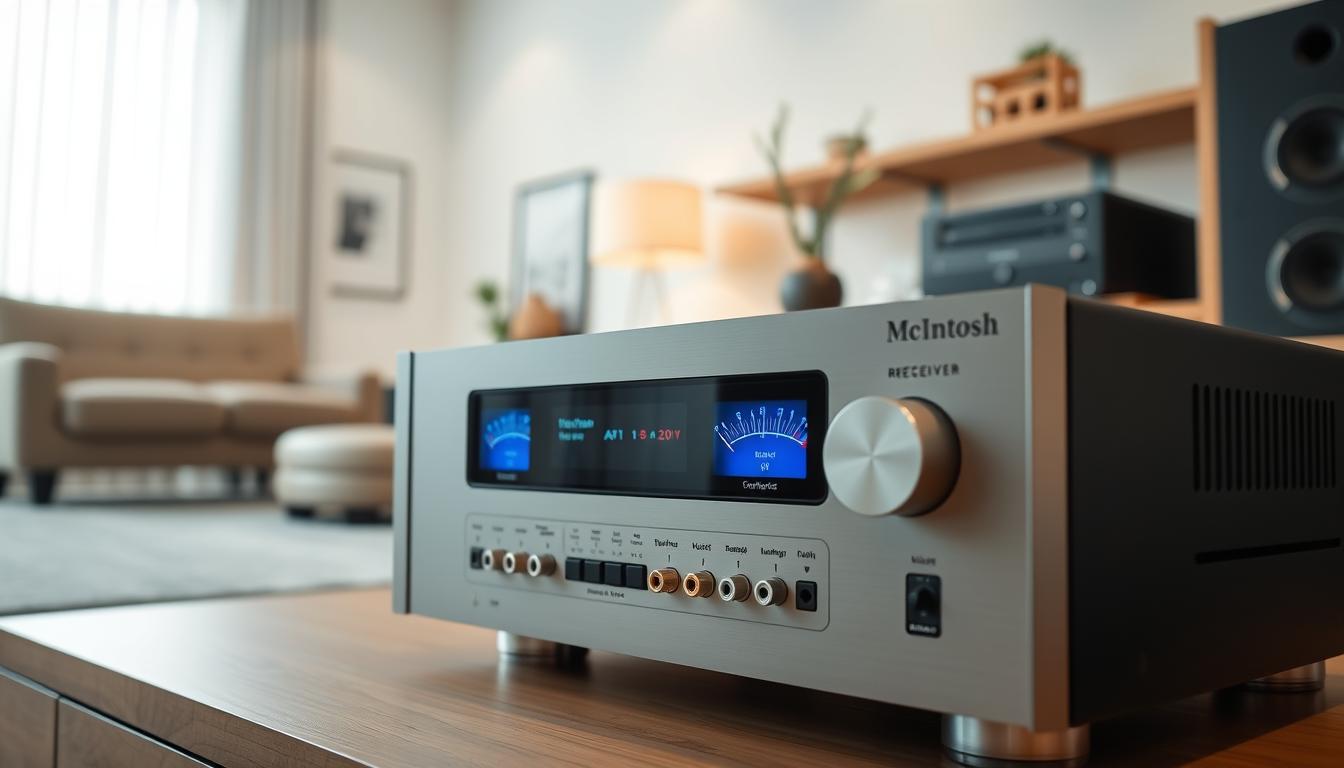
Investment Value: McIntosh Receivers in the Audiophile Market
The world of audiophiles loves McIntosh receivers for their sound and value. They are perfect for collectors or investors. These iconic audio components have a rich history and are made with great care.
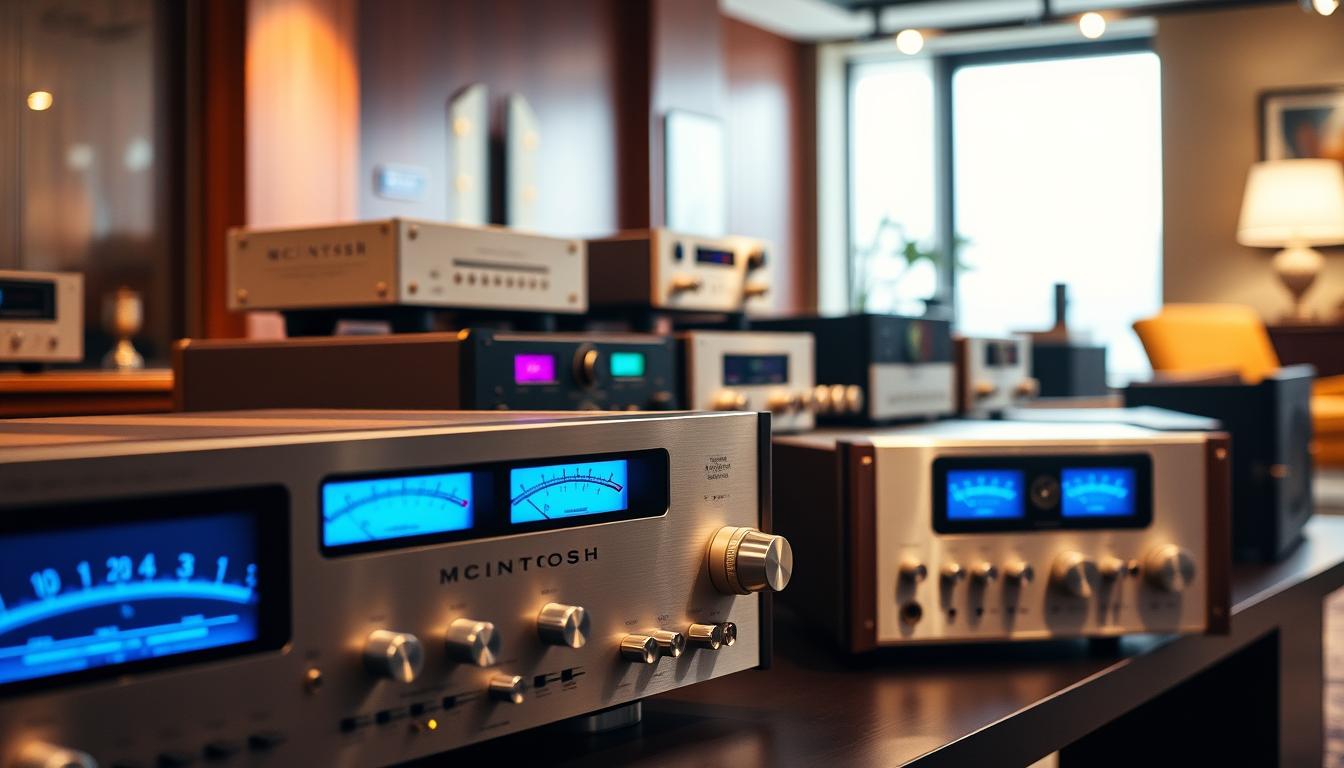
Price Trends and Appreciation Patterns
McIntosh receivers have grown in value over time. They are great for those who want to invest in something real. The rarity and condition of a receiver greatly affect its price.
Most Collectible Models and Rarities
Some models, like the MAC1500 and MAC4300V, are very popular among collectors. They are valuable because of their history and sound quality. These rare items can sell for a lot at auctions.
Condition Impact on Valuation
The state of a McIntosh receiver is key to its worth. Receivers in top shape are highly sought after. They can even get a higher price.
Long-Term Investment Strategies
Investing in McIntosh receivers means looking ahead. It’s important to know the market and what affects these receivers’ value.
Acquisition Approaches for Collectors
Collectors should buy from trusted dealers or auctions. This ensures the item is real and in good shape. Talking to other collectors and experts can also help a lot.
Insurance and Protection Considerations
With the value of McIntosh receivers, getting insurance is a smart move. It protects against loss or damage. Keeping them in good condition also helps maintain their value.
As a famous audiophile once said,
“McIntosh receivers are not just pieces of equipment; they are investments in a legacy of sound quality and craftsmanship.”
The Future of McIntosh Receivers
Are you curious about what’s next for McIntosh receivers? With a long McIntosh Audio Receiver History, they’re ready to keep innovating. They aim to break new ground in home audio.
Upcoming Models and Innovations
McIntosh is all about using the latest tech in their receivers. They’re working on better digital integration and streaming.
Digital Integration and Streaming Technologies
Look for better streaming service support and digital signal processing. For example, Yamaha has already made big strides in digital tech.
Design Evolution and New Features
McIntosh is also updating their designs. They’re adding new features to improve both user experience and sound quality. Some of these might include:
- Improved wireless connectivity
- Enhanced voice control capabilities
- Advanced room calibration technologies
Preserving the McIntosh Legacy
McIntosh is dedicated to keeping their legacy alive. They aim to mix tradition with new ideas. This way, their products stay appealing to both old and new fans.
Balancing Tradition with Innovation
McIntosh stays true to their roots while adding modern touches. They blend old values with new tech and design.
The Continuing Appeal to New Generations
By updating their products, McIntosh draws in new fans. These fans value quality and innovation.
Conclusion: The Timeless Appeal of McIntosh Receivers
You’ve looked into McIntosh receivers’ rich history and wide range. From the early MAC1500 to the latest models, they stand out. Their quality, sound, and design make them special.
When you buy a McIntosh Stereo Receiver, you’re getting more than just audio gear. You’re investing in a legacy of excellence.
For those comparing McIntosh Receivers, each model has its own strengths. The MAC1900 shines with power, while the MAC4300V offers versatility. McIntosh is known for its innovation and quality, setting a high standard in audio.
Looking to upgrade your home audio? McIntosh receivers are a great choice. They provide detailed information to help you decide. With their lasting quality and sound, McIntosh receivers remain a top pick for audiophiles, securing their spot in high-end audio for years.
FAQ
What are the most popular McIntosh receiver models?
Popular McIntosh receiver models include the MAC1500, MAC1700, and MAC1900. Also, the MAC4100, MAC4200, and MR87 are favorites. Each model has unique features and sound quality.
How do I identify a genuine McIntosh receiver?
To spot a real McIntosh receiver, look for the McIntosh logo. Check the serial number against McIntosh’s database. Also, inspect the build quality and design, which are typical of McIntosh products.
What is the significance of the McIntosh sound signature?
McIntosh’s sound signature is known for its clarity, warmth, and power. This makes McIntosh receivers a top choice for audiophiles who value high-quality audio.
Can I integrate a vintage McIntosh receiver with modern audio systems?
Yes, you can connect a vintage McIntosh receiver with modern systems. You might need extra components or adapters for digital sources and modern speakers.
Are McIntosh receivers a good investment?
McIntosh receivers, like rare and vintage models, can increase in value. They are a good investment for collectors and audiophiles.
How do I restore a vintage McIntosh receiver?
Restoring a vintage McIntosh receiver needs careful checking of its condition. You’ll need to find original or compatible parts. Sometimes, professional help is needed to ensure the restoration is done right.
What are the key features to look for when buying a used McIntosh receiver?
When buying a used McIntosh receiver, check its condition and look for wear or repairs. Make sure it’s authentic and meets your audio needs.
How do McIntosh receivers compare in terms of sound quality?
McIntosh receivers are known for their high-quality sound. Each model has its own sonic characteristics. Comparing them can help you find the best fit for your listening preferences.
What is the future of McIntosh receivers?
McIntosh keeps innovating, adding new technologies while keeping their quality and sound excellence. This ensures their receivers stay appealing to both current and new audiophiles.
Can McIntosh receivers be used for home theater systems?
Yes, many McIntosh receivers work well with home theater systems. They offer features like multi-channel support and compatibility with various audio formats.
